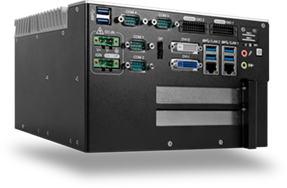Electrostatic discharge damage is far more than just a surprising jolt when you reach for a door handle. That tiny jolt can play havoc on a computer’s unprotected systems if you don’t take the necessary precautions.
What is Electrostatic Discharge?
Electrostatic discharge (ESD) is the natural phenomenon that occurs when two objects meet and exchange electrons. One object gains electrons and becomes electrically negative, while the other loses electrons and becomes electrically positive. An electrostatic discharge occurs when electrons from a negatively charged object that aren’t moving, or “static,” suddenly jump to a positively charged object. This creates the distinctive jolt that people associate with static electricity.
The human body can safely store and conduct small amounts of electricity, and we do so all the time. However, the human body is far more resilient against sudden changes in electric charge than, say, the circuits of a computer. Even rugged mini PCs must be designed with protection against ESD in mind.
What Can Electrostatic Discharge Damage Affect?
Even a small amount of ESD can damage the vulnerable components of a computer. The most critical areas where electrostatic discharge damage can occur are:
CMOS Circuits
One of the most vulnerable parts of a computer when it comes to ESD is its CMOS circuits. CMOS (complementary metal oxide semiconductor) circuits are the basis for modern integrated circuits, which in turn are the basis for all modern computers. CMOS circuits are extremely popular as they consume very little power and operate very quickly.
However, CMOS circuits also possess very thin layers of insulation, which makes them highly vulnerable to ESD damage. Enough of an ESD event can outright destroy these circuits if it reaches them.
Data (HDDs and SSDs)
Both hard disk drives (HDDs) and solid-state drives (SSDs) rely on electricity to save and access information. However, too much electricity via ESD can damage or destroy the data saved on the device in question. While SSDs are somewhat more protected than HDDs because of their fully enclosed design, the threat is still present for both methods of data storage.
Peripheral Devices
Even larger devices like mice and keyboards are not immune to electrostatic discharge damage. ESD can easily damage or destroy the circuits controlling a peripheral device, rendering it useless. Users must keep this in mind and avoid habits or actions that build up static electricity in their bodies before handling peripherals.
Design Features and Products That Prevent ESD
To counter the threat of ESD, various products and features exist to help workers and end-users negate static electricity buildup and prevent it from affecting the electronics they’re handling.
Anti-Static Coating
An anti-static coating is exactly what the name implies; it is an applied coating that prevents ESD from occurring. These coatings provide an electrically conductive surface that dissipates static charge before it can damage sensitive electronics. Anti-static coatings often come in the form of spray formulas or liquids that can be applied to surfaces that need to negate ESD build-up. For example, spraying an anti-static coating on the floor where workers are walking prevents them from generating static electricity while moving, ensuring they don’t shock computer components while handling them.
Anti-Static Mats and Grounding Points
A variety of anti-static mats and pads exist to help negate the risk of ESD. These mats can be placed either on a desk for the computer to rest on or on the ground for workers to stand on. They are typically used in conjunction with a personal grounding wrist strap, and together they draw electrostatic charge away from the user and safely into the ground. These mats have a high amount of electrical resistance, which means static discharge can slowly “flow” away from the body and prevent charge from building in the first place.
TVS Diodes
Transient voltage suppressor diodes, or TVS diodes, are designed to protect electronic systems from random voltage spikes and transient surges, such as ESD. A TVS diode filters current passing through an electrical circuit and can suppress how much voltage passes through. ESD diodes can absorb excess voltage and create a low-impedance path to divert it towards the ground, protecting the rest of the circuit. This makes TVS diodes a common fixture in both consumer- and industrial-grade electronics, such as industrial panel PCs.
Conformal Coating
A conformal coating is a coating of material, usually acrylic, silicone, or urethane, that is directly applied to computer components, such as a printed circuit board. These coatings help insulate the circuitry underneath from errant electrical discharges without interfering with the computer’s operations.
How To Prevent ESD Damage As A User
Along with using specific products and features, computer manufacturers and IT professionals must follow well-established procedures for preventing electrostatic discharge damage.
Keep the PC Grounded
Keeping the computer grounded while working on it gives electricity somewhere to flow rather than remaining in the device. Plugging the computer into an outlet while working on it (while having it completely powered off, of course) helps prevent static electricity from seriously damaging the circuitry within.
Avoiding Certain Materials Or Actions
We’re all familiar with the childhood prank of rubbing your sock-clad feet against the carpet to build up a static charge, then zapping someone with a single touch. Anyone working on a computer’s internal components should avoid similar actions that can cause static build-up. Also something to avoid is clothing that is especially ESD-prone, such as wool. IT workers will often wear specialized footwear with leather soles to prevent static build-up.
Follow Proper Handling Procedures
Before technicians handle a computer’s components, they will often touch a metal part of the computer’s case. This grounds them and helps neutralize any static charge they may be carrying. Touching the case occasionally while working will also help counteract any buildup. Another best practice is to hold circuit boards at the edges and keep fingers away from any conductive parts, such as the circuitry itself.
Have a Humid Environment
Static builds up quickly in areas with dry air, while moisture helps static charge dissipate. For this reason, computer manufacturing environments will often use humidifiers to eliminate static electricity by keeping humidity at roughly 55%..
ESD-Protected Computers from Cybernet Manufacturing
If not properly countered, electrostatic discharge damage can quickly destroy vital computer equipment that businesses rely on. Fortunately, there are numerous methods and tools for dealing with this threat.
If you need computers that can work in high-static environments, contact the team at Cybernet Manufacturing. Our medical and industrial computers are equipped with numerous features that help reduce the threat of ESD, and our experienced team of experts can suggest other products and best practices to further mitigate the issue.

